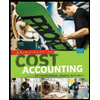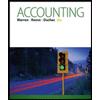
EP HORNGREN'S FINAN.+MGRL.ACCT.-ACCESS
7th Edition
ISBN: 9780136516309
Author: MILLER-NOBLES
Publisher: PEARSON CO
expand_more
expand_more
format_list_bulleted
Textbook Question
Chapter 5, Problem 19RQ
What are the four steps involved in the closing process for a merchandising company?
Expert Solution & Answer
Want to see the full answer?
Check out a sample textbook solution
Students have asked these similar questions
Which is not an objective of internal controls?A. Safeguard assetsB. Improve profitsC. Ensure accurate recordsD. Promote operational efficiencyneed help
Which is not an objective of internal controls?A. Safeguard assetsB. Improve profitsC. Ensure accurate recordsD. Promote operational efficiencyno ai
Can you solve this general accounting problem using appropriate accounting principles?
Chapter 5 Solutions
EP HORNGREN'S FINAN.+MGRL.ACCT.-ACCESS
Ch. 5 - Which account does a merchandiser use that a...Ch. 5 - The two main inventory accounting systems are the...Ch. 5 - The journal entry for the purchase of inventory on...Ch. 5 - JC Manufacturing purchase d inventory for 5,300...Ch. 5 - Prob. 5QCCh. 5 - Suppose Daves Discounts Merchandise Inventory...Ch. 5 - Which of the following accounts would be closed at...Ch. 5 - What is the order of the subtotals that appear on...Ch. 5 - Prob. 9QCCh. 5 - Prob. 10AQC
Ch. 5 - Prob. 11BQCCh. 5 - What is a merchandiser, and what is the name of...Ch. 5 - Prob. 2RQCh. 5 - Describe the operating cycle of a merchandiser.Ch. 5 - What is Cost of Goods Sold (COGS), and where is it...Ch. 5 - How is gross profit calculated, and what does it...Ch. 5 - What are the two types of inventory accounting...Ch. 5 - What is an invoice?Ch. 5 - What account is debited when recording a purchase...Ch. 5 - Prob. 9RQCh. 5 - What is a purchase return? How does a purchase...Ch. 5 - Prob. 11RQCh. 5 - How is the net cost of inventory calculated?Ch. 5 - What are the two journal entries involved when...Ch. 5 - Prob. 14RQCh. 5 - When granting a sales allowance, is there a return...Ch. 5 - Prob. 16RQCh. 5 - Prob. 17RQCh. 5 - Prob. 18RQCh. 5 - What are the four steps involved in the closing...Ch. 5 - Prob. 20RQCh. 5 - Prob. 21RQCh. 5 - Prob. 22RQCh. 5 - Prob. 23RQCh. 5 - Prob. 24ARQCh. 5 - Prob. 25BRQCh. 5 - Prob. 26BRQCh. 5 - Prob. 27BRQCh. 5 - Prob. 28BRQCh. 5 - Prob. 29BRQCh. 5 - Prob. 30BRQCh. 5 - Prob. 31BRQCh. 5 - Comparing periodic and perpetual inventory systems...Ch. 5 - Prob. 5.2SECh. 5 - Prob. 5.3SECh. 5 - Prob. 5.4SECh. 5 - Prob. 5.5SECh. 5 - Prob. 5.6SECh. 5 - Prob. 5.7SECh. 5 - Prob. 5.8SECh. 5 - Prob. 5.9SECh. 5 - Prob. 5.10SECh. 5 - Prob. 5.11SECh. 5 - Prob. 5.12SECh. 5 - Prob. 5.13SECh. 5 - Prob. 5.14SECh. 5 - Prob. 5.15SECh. 5 - Prob. 5.16SECh. 5 - Prob. 5.17SECh. 5 - Prob. 5.18SECh. 5 - Prob. 5.19SECh. 5 - For all exercises, assume the perpetual inventory...Ch. 5 - Journalizing purchase transactions from an invoice...Ch. 5 - Prob. 5.22ECh. 5 - Prob. 5.23ECh. 5 - Prob. 5.24ECh. 5 - Prob. 5.25ECh. 5 - Use the following information to answer Exercises...Ch. 5 - Prob. 5.27ECh. 5 - Prob. 5.29ECh. 5 - Prob. 5.30ECh. 5 - Prob. 5.31ECh. 5 - Prob. 5.32ECh. 5 - Prob. 5.33ECh. 5 - Prob. 5.34ECh. 5 - Prob. 5.35ECh. 5 - Prob. 5.36APCh. 5 - Prob. 5.37APCh. 5 - Prob. 5.38APCh. 5 - Prob. 5.39APCh. 5 - Prob. 5.40APCh. 5 - Prob. 5.41APCh. 5 - Prob. 5.42APCh. 5 - Prob. 5.43BPCh. 5 - Prob. 5.44BPCh. 5 - Prob. 5.45BPCh. 5 - Prob. 5.46BPCh. 5 - Prob. 5.47BPCh. 5 - Prob. 5.48BPCh. 5 - Prob. 5.49BPCh. 5 - Prob. 5.50CPCh. 5 - Prob. 5.51CPCh. 5 - Prob. 5.52PSCh. 5 - Prob. 5.1CTDCCh. 5 - Prob. 5.1CTEICh. 5 - Prob. 5.1CTFC
Knowledge Booster
Learn more about
Need a deep-dive on the concept behind this application? Look no further. Learn more about this topic, accounting and related others by exploring similar questions and additional content below.Similar questions
- Which is not an objective of internal controls?A. Safeguard assetsB. Improve profitsC. Ensure accurate recordsD. Promote operational efficiency no aiarrow_forwardPlease provide the accurate answer to this financial accounting problem using appropriate methods.arrow_forwardI am searching for the accurate solution to this financial accounting problem with the right approach.arrow_forward
- 20 Nelson and Murdock, a law firm, sells $8,000,000 of four-year, 8% bonds priced to yield 6.6%. The bonds are dated January 1, 2026, but due to some regulatory hurdles are not issued until March 1, 2026. Interest is payable on January 1 and July 1 each year. The bonds sell for $8,388,175 plus accrued interest. In mid-June, Nelson and Murdock earns an unusually large fee of $11,000,000 for one of its cases. They use part of the proceeds to buy back the bonds in the open market on July 1, 2026 after the interest payment has been made. Nelson and Murdock pays a total of $8,456,234 to reacquire the bonds and retires them. Required1. The issuance of the bonds—assume that Nelson and Murdock has adopted a policy of crediting interest expense for the accrued interest on the date of sale.2. Payment of interest and related amortization on July 1, 2026.3. Reacquisition and retirement of the bonds.arrow_forward13 Which of the following is correct about the difference between basic earnings per share (EPS) and diluted earnings per share? Question 13 options: Basic EPS uses comprehensive income in its calculation, whereas diluted EPS does not. Basic EPS is not a required disclosure, whereas diluted EPS is required disclosure. Basic EPS uses total common shares outstanding, whereas diluted EPS uses the weighted-average number of common shares. Basic EPS is not adjusted for the potential dilutive effects of complex financial structures, whereas diluted EPS is adjusted.arrow_forwardPlease explain the solution to this general accounting problem with accurate explanations.arrow_forward
- I need guidance with this financial accounting problem using the right financial principles.arrow_forwardGeneral Accounting Question Solutionarrow_forwardWhich is not an objective of internal controls?A. Safeguard assetsB. Improve profitsC. Ensure accurate recordsD. Promote operational efficiencyarrow_forward
arrow_back_ios
SEE MORE QUESTIONS
arrow_forward_ios
Recommended textbooks for you
 College Accounting (Book Only): A Career ApproachAccountingISBN:9781337280570Author:Scott, Cathy J.Publisher:South-Western College Pub
College Accounting (Book Only): A Career ApproachAccountingISBN:9781337280570Author:Scott, Cathy J.Publisher:South-Western College Pub Principles of Cost AccountingAccountingISBN:9781305087408Author:Edward J. Vanderbeck, Maria R. MitchellPublisher:Cengage LearningPrinciples of Accounting Volume 2AccountingISBN:9781947172609Author:OpenStaxPublisher:OpenStax College
Principles of Cost AccountingAccountingISBN:9781305087408Author:Edward J. Vanderbeck, Maria R. MitchellPublisher:Cengage LearningPrinciples of Accounting Volume 2AccountingISBN:9781947172609Author:OpenStaxPublisher:OpenStax College- Principles of Accounting Volume 1AccountingISBN:9781947172685Author:OpenStaxPublisher:OpenStax College
 Accounting (Text Only)AccountingISBN:9781285743615Author:Carl Warren, James M. Reeve, Jonathan DuchacPublisher:Cengage Learning
Accounting (Text Only)AccountingISBN:9781285743615Author:Carl Warren, James M. Reeve, Jonathan DuchacPublisher:Cengage Learning Managerial AccountingAccountingISBN:9781337912020Author:Carl Warren, Ph.d. Cma William B. TaylerPublisher:South-Western College Pub
Managerial AccountingAccountingISBN:9781337912020Author:Carl Warren, Ph.d. Cma William B. TaylerPublisher:South-Western College Pub

College Accounting (Book Only): A Career Approach
Accounting
ISBN:9781337280570
Author:Scott, Cathy J.
Publisher:South-Western College Pub

Principles of Cost Accounting
Accounting
ISBN:9781305087408
Author:Edward J. Vanderbeck, Maria R. Mitchell
Publisher:Cengage Learning

Principles of Accounting Volume 2
Accounting
ISBN:9781947172609
Author:OpenStax
Publisher:OpenStax College

Principles of Accounting Volume 1
Accounting
ISBN:9781947172685
Author:OpenStax
Publisher:OpenStax College

Accounting (Text Only)
Accounting
ISBN:9781285743615
Author:Carl Warren, James M. Reeve, Jonathan Duchac
Publisher:Cengage Learning

Managerial Accounting
Accounting
ISBN:9781337912020
Author:Carl Warren, Ph.d. Cma William B. Tayler
Publisher:South-Western College Pub
ACCOUNTING BASICS: Debits and Credits Explained; Author: Accounting Stuff;https://www.youtube.com/watch?v=VhwZ9t2b3Zk;License: Standard Youtube License